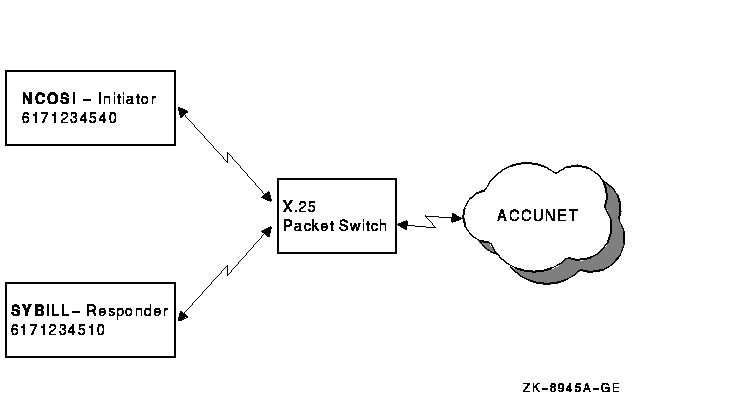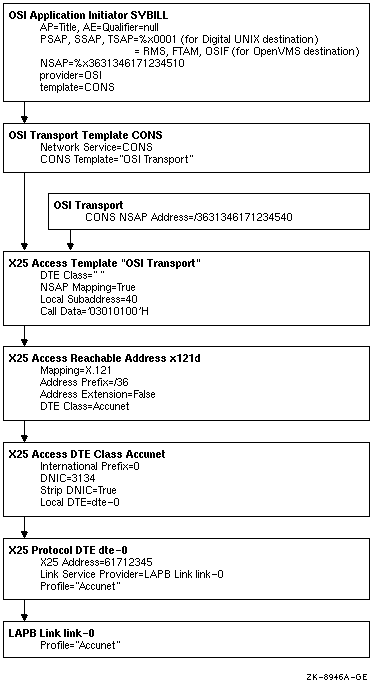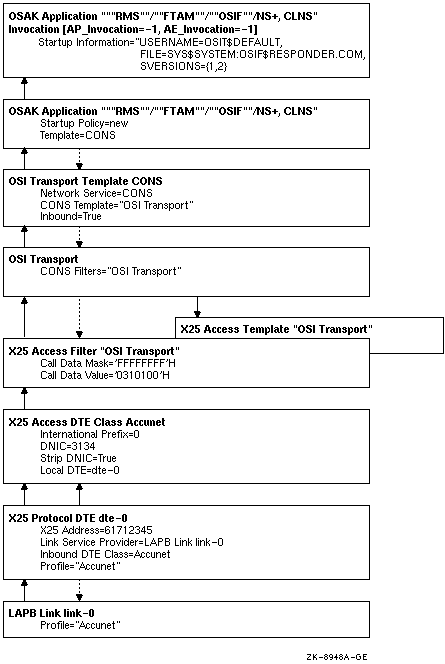HP OpenVMS Systems Documentation |
DECnet-Plus for OpenVMS
|
| Previous | Contents | Index |
You cannot configure the X.25 CONS protocol stack on DECnet-Plus end system products using the configuration tools alone. To successfully configure the stack, you must understand NCL and the management entities in the X.25 CONS stack. Table 8-17 shows the management entities used at each layer of the protocol stack.
The X.25 and LAPB protocols allow many options that vary among X.25 networks. DIGITAL's products provide X.25 network profiles that contain all the pertinent network parameters for most PSDNs. For example, profiles contain the default value and permissible range for the X.25 window size. The system administrator specifies the profile name during system configuration. Typically, the profile name corresponds to the name of the PSDN.
The X.25 and X.25 Access software components follow instructions from both their user applications and their management entities. You cannot control the behavior of these components entirely by management. In some cases, X.25 and X.25 Access software ignore certain management parameters, depending on which functions an X.25 application uses.
| Protocol Layer | Management Entity | Function in CONS Stack |
|---|---|---|
| ACSE, Presentation, and Session |
osak
osak application osak application invocation |
Defines the OSI application's ACSE, Presentation, and Session addresses for incoming connections. |
| Transport Class 0 |
osi transport
osi transport application osi transport port osi transport template |
Defines which outgoing connections pass through X.25. Routes incoming requests to OSAK based on the TSEL. |
| X.25 Packet Layer |
x25 access
x25 access application x25 access dte class x25 access filter x25 access port x25 access reachable address x25 access security dte class x25 access security filter x25 access template x25 access protocol x25 protocol dte |
Translates between NSAP and X.25 network addresses. Establishes a connection to the X.25 network service provider. Routes incoming calls to OSI transport, based on received X.25 call packet contents. Controls access from the X.25 network to the computer system. |
| LAPB Link Layer |
lapb
lapb link lapb port |
Controls datalink buffers and timers. |
| Modem Connect |
modem connect
modem connect line modem connect data port |
Controls physical attributes of the modem connection. |
Example Configuration
The following illustrated configuration and the examples that follow help clarify the interrelationships among management entities for outgoing and incoming calls using X.25 CONS. Assume the end system implementations NCOSI and SYBILL are connected to a local X.25 packet switch, which in turn is connected to an AT&T Accunet line, as shown in Figure 8-17.
Figure 8-17 Example Configuration

Accunet addresses are NTN-based, similar to PACNET. All addresses discussed in this section are based on conversion rules defined in international standards.
NCOSI is set up as the OSI application initiator, SYBILL as the responder. AT&T assigned a range of addresses to the line from 6171234500 to 6171234599.
The Accunet DNIC is 3134, and the international prefix is 0. NCOSI has a local subaddress of 40, and SYBILL has a local subaddress of 10. From these subaddresses, the remaining addresses are derived using the conversion rules explained in Section 8.8.2.1. Table 8-18 lists these addresses.
| Source: NCOSI | Destination: SYBILL | |
|---|---|---|
| Accunet DNIC | 3134 | 3134 |
| Accunet Line Address | 6171234500-99 | 6171234500-99 |
| X.25 Profile | Accunet | Accunet |
| Local Subaddress | 40 | 10 |
| X.25 Network Address | 61712345 | 61712345 |
| X.121 Address | 31346171234540 | 31346171234540 |
| Address Extension Facility | 103631346171234540 | 103631346171234510 |
Outgoing Connections
Figure 8-18 shows the entity relationships for outgoing connections. The following actions occur during an outgoing call:
Figure 8-18 Entity Relationships for Outgoing Connections

Incoming Connections
Figure 8-19 shows the entity relationships for incoming connections.
Figure 8-19 Entity Relationships for Incoming Connections

The following initialization actions take place before incoming connections can be accepted.
The following occurs upon receipt of an incoming call on an X.25 DTE:
The DECnet-Plus configuration procedure always configures the CLNS stack. You cannot use this procedure to configure the CONS stack alone.
By default, the DECnet-Plus for OpenVMS configuration procedure configures HDLC on WAN devices. This blocks X.25 access to the same devices. Use the advanced configuration procedure to override this default.
Manually add specific NCL commands to the configuration procedures to complete the configuration, as shown in the following examples.
All DECnet-Plus end system products support manual x25 access reachable addresses entities, allowing mapping of NSAPs to any X.25 network address. Set the default configuration to perform X.121 mapping without address extension facilities, as shown in this document. Use manual X.25 access reachable addresses only for destinations with non-X.121-based NSAPs.
X.25 and X.25 Access software provide controls to screen incoming calls with the x25 access filter and x25 access security filter entities. These mechanisms allow you to define access to the system based on call data such as source and destination addresses. The examples below do not use them. See X.25 documentation for more information.
The following subsections show examples from procedures used to configure OpenVMS Alpha and VAX systems. The procedures were performed on pristine systems that include only the base operating system and the minimum appropriate licenses. The system parameters are set as defined in the DECnet-Plus and X.25 documentation.
The addresses shown in these examples differ from the ones listed in Table 8-18. DECnet-Plus for OpenVMS requires an extra octet containing the NSAP length in digits to precede the actual NSAP value. |
OpenVMS Alpha Configuration of OSI Transport Over X.25
CONS
Take the following steps to configure FTAM (and other OSI applications) with OSI Transport over X.25 CONS on an OpenVMS Alpha system. For more information on FTAM configuration, see the DECnet-Plus FTAM and Virtual Terminal Use and Management guide.
$ PRODUCT INSTALL DECNET_OSI |
$ @NET$CONFIGURE ADVANCED |
$ PRODUCT INSTALL X.25 |
$ @X25$CONFIGURE ADVANCED |
set lapb link link-0 sequence modulus 8 set x25 access dte class accunet internationalprefix 0 set x25 access dte class accunet dnic 3134 set x25 access dte class accunet strip dnic true set x25 access reachable address x121d dte class accunet set x25 access template "osi transport" local subadd 6171234540 |
$ PRODUCT INSTALL OSAK, FTAM, VT |
$ @OSIF$CONFIGURE |
$ EDIT/EDT SYS$SYSTEM:ISOAPPLICATIONS.DAT |
$ @SYS$STARTUP:OSAK$START $ @SYS$STARTUP:OSIF$STARTUP |
NCL> ADD OSI Transport CONS NSAP Addresses {/103631346171234540 }
NCL> SET OSI Transport Template CONS Loc NSAP/103631346171234540
NCL> SET OSI Transport Template CONS Classes {0, 2 }
|
OpenVMS VAX Configuration of OSI Transport Over X.25
CONS
Take the following steps to configure FTAM (and other OSI applications) with OSI Transport over X.25 CONS on OpenVMS VAX systems. For more information on FTAM configuration, see the DECnet-Plus FTAM and Virtual Terminal Use and Management guide.
$ PRODUCT REG PROD VMS /VER=V7.0 /SOURCE=SYS$UPDATE: |
$ PRODUCT INSTALL DECNET_OSI |
$ @NET$CONFIGURE ADVANCED |
Do you want to configure Wide Area Devices? Y Do you wish to use WANDRIVER? Y Will you use DEC HDLC? N Will you use LAPB/E? Y Do you have any soft-loadable microcode devices on this system? Y Do you want asynchronous datalink support? N Data Link protocol for DSV-0-0 (DSV-11)? NONE Data Link protocol for DSV-0-1 (DSV-11)? NONE Do you want to create additional OSI templates? Y Type of network service (CLNS/CONS/RFC1006)? CONS Name of the OSI template? CONS Transport classes to support? 0,2 Do you want to create addional OSI templates? N |
$ @PSI$CONFIGURE ADVANCED |
Type of VAX P.S.I. configuration? Native Do you want to configure any synchronous lines? Y Select a line speed for your DTE: 9.6 X.25 DTE Address: 61712345 Logical Channel Ranges: [[1..127]] Profile Name: ACCUNET Do you wish to set up any PVCs? N Do you wish to create any Closed User Groups? N Do you wish to use LLC2 communications? N Do you wish to set up any applications? N Do you wish to set up additional templates? Y Template Name: "OSI Transport" DTE Class: ACCUNET Call Data: %x03010100 Charging Information: NO Local Subaddress: 40 NSAP Mapping: YES Do you want X.25 or X.29 programs to specify filter names in $QIO calls? YES Do you want IO$_ACPCONTROL calls issued by your programs to name any static filters? YES Filter Name: "OSI Transport" Call Data Value: %x03010100 Call Data Mask: %xFFFFFFFF Do you want to set up X.25 Security? NO Do you wish to create an NCL script now? Yes |
create x25 access reachable address x121d address prefix /36
set x25 access reachable address x121d mapping x.121
set x25 access reachable address x121d dte class accunet
set x25 access reachable address x121d address extensions true
add osi transport cons nsap addresses {/103631346171234540 }
|
$ PRODUCT INSTALL OSAK, FTAM, VT |
$ @OSIF$CONFIGURE |
$ EDIT/EDT SYS$SYSTEM:ISOAPPLICATIONS.DAT |
$ @SYS$STARTUP:OSAK$START $ @SYS$STARTUP:OSIF$STARTUP |
Dynamically-assigned circuits are used for making infrequent
connections to destinations outside the routing domain of your
DECnet-Plus system. (A routing domain is a collection of systems that
automatically configure to each other and exchange network topology
information using consistent Network layer protocols.)
Dynamically-assigned circuits are established upon arrival of data and
are cleared when no more data is transmitted or received during a
specified time (idle time).
8.8.3.1 Addressing Issues for Dynamically Assigned Circuits
When using dynamically-assigned X.25 routing circuits, the sending and receiving nodes must be in separate routing domains. The routing domain is defined with a unique AFI, IDI, and PreDSP combination in the NSAP address (see Figure 8-16). The format of the CLNS address must conform to that described in the DECnet-Plus Planning Guide.
The requirement for separate routing domains places two restrictions on addressing:
If your DECnet-Plus system is isolated from the network and uses the dynamically-assigned X.25 routing circuit for communication, you may find it convenient to assign an NSAP address to your system that is based on your X.25 network address. If you do this, you must use the binary format of an X.121 address (AFI 37 or 53), as opposed to the decimal format described in Section 8.8.2.1 for X.25 CONS configurations. Section 8.4.1.6 explains how to use manual network entity titles to define the NSAP address for your system.
For each dynamically-assigned X.25 routing circuit, you must configure one or more reachable addresses. A reachable address defines a mapping between network service access points (NSAPs) and data terminal equipment (DTE) addresses used in X.25. An NSAP identifies a system in the network and is used by both the Network and Transport layers of DECnet-Plus. X.25 uses a DTE address to identify the end point of an SVC. Reachable addresses identify which NSAP or group of NSAPs should be sent over a particular X.25 circuit.
Use the routing circuit reachable address entity when configuring routing over X.25 dynamically-assigned circuits. Do not use the x25 access reachable address entity. The x25 access reachable address entity applies only to OSI transport over X.25 CONS configurations, as described in Section 8.8.2. |
Consider the following example of two systems connected by an X.25 network:
| System A | System B | |
|---|---|---|
| NSAP | 48::00-5F:08-00-2B-16-A8-72:21 | 43:15082267643:0045:08002B16DE4F:21 |
| DTE | 075527537 | 18628935742674 |
The reachable address on System A specifies that if the destination NSAP matches the value 43:15082267643:0045:08002B16DE4F:21, then an X.25 circuit should be created by connecting to the DTE address 18628935742674. This example is a case of one-to-one NSAP-to-DTE mapping. The reachable address could also be set up such that any NSAP with the initial digits 43:15082267643 should be sent over that X.25 circuit, which would potentially cause many different NSAPs to be mapped to that particular X.25 circuit.
The NCL commands to create and initialize reachable addresses are created in the SYS$STARTUP:NET$OSI_TRANSPORT_STARTUP.NCL script (for OSI transport using CONS) and the SYS$STARTUP:NET$ROUTING_STARTUP.NCL script (for Routing using X.25).
The following example shows how to manually create a reachable address for routing using NCL. For more information on configuring routing, see Section 8.4.
ncl> create routing circuit x25_circuit-1 reachable address ughh_v -
_ncl> address prefix /4145418715004108002b0ed41e
ncl> set routing circuit x25_circuit-1 reachable address ughh_v -
_ncl> dte address { 2267643 }
ncl> set routing circuit x25_circuit-1 reachable address ughh_v -
_ncl> mapping manual
ncl> enable routing circuit x25_circuit-1 reachable address ughh_v
|
Specify the address prefix when you create the routing circuit entity. You cannot modify this attribute with the setcommand.
The X.25 configuration procedure automatically creates the following two X25 Access reachable addresses:
| Previous | Next | Contents | Index |